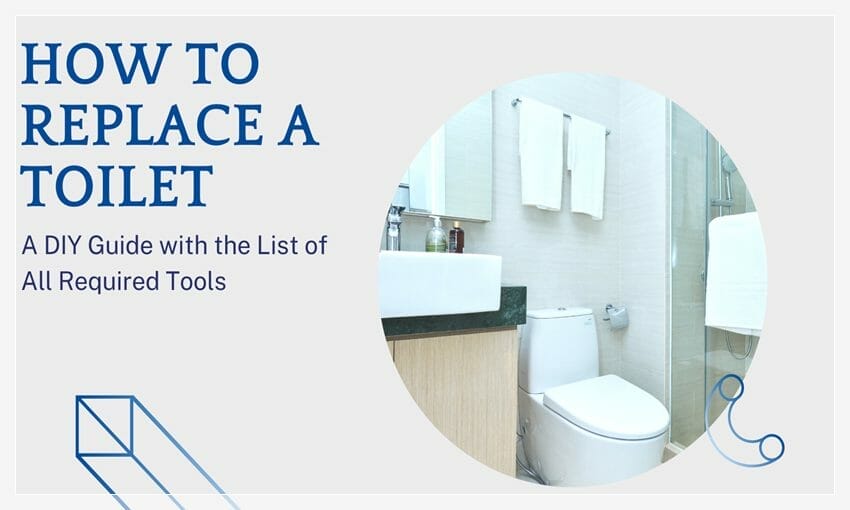
Replacing a toilet is not an easy process, but it is often necessary. Toilets are known for developing issues that can’t be fixed without replacing them. One of the most common problems with toilets is leakage from the tank and bowl. If you notice water on your floor or in your bathroom, then you should contact a plumber to replace your toilet before major damage occurs. This article will guide you through how to replace a toilet with all of the tools that you will need!
If you need to replace your toilet, then this guide is for you! By following these steps and tips, anyone can successfully fix their leaky toilet.
Tools Required
- Plumber’s Putty or Flange Sealant
- Extension Rods or Wrench(es)
- Adjustable Angle Casing (optional but recommended)
- Replacement Toilet Wax Ring Kit with Mounting Bolt Hardware
Toilet Replacement Steps:
Here is a DIY guide on toilet replacement. If you follow these steps one by one, then you can do it easily within a short time. So, let’s go to follow these instructions perfectly.
Step One: Remove the Old Toilet
The old toilet needs to be removed for you to install a new one. This is very easy as well! All you have to do is cut any piping or tubing that might be present and unscrew it from the floor flange. Once all of those things are taken care of, then use your wrench(es) (or an extension rod) on its water supply connections until they come loose, and finally disconnecting its sewer hose by loosening the nuts at both ends with your wrench(es). Then remove any leftover parts such as bolts, screws, etc., using pliers if necessary.
Once this has been done, take off anything else that may need removing such as mounting brackets or any other fixtures that may have been present.
Step Two: Installing the New Toilet
The new toilet needs to be installed for you to fix your plumbing issue and finally get rid of those pesky leaks! All you need are a few more tools from your kit, such as a tube cutter (if one is not included), Teflon tape, pipe joint compound or PVC cement, and some silicone sealant. Take all these items out so they’re ready before starting this step. The first thing you want to do know is measured how far up from the floor the bottom of the toilet will meet concerning where it’s going on top of whatever type of surface there might be underneath it.
You’ll find information on how to diagnose and replace a toilet, including the list of tools needed.
Step One: Diagnosing the Problem
The first place you should start when trying to solve any plumbing problem is by diagnosing it! When there may be something wrong with your toilets or sinks, leaks are often one of two things that might have caused them – either due to damaged pipes or loose connections between fixtures themselves in the line. If a leak occurs from a pipe going from the wall into your bathroom, then this article will not help you as much because these types of problems require professional assistance. However, if your leaking issue comes down more towards just contaminants getting stuck inside your fixture’s piping system (which can happen for many reasons), then read on.
So you can diagnose your problem, it is important to find the area where you can almost visibly see a leak coming from. Usually, this will be in your tank or the toilet or on one side of the sink if there’s an issue with that fixture – but sometimes leaks come from unexpected places like toilets plugged into fixtures upstairs and then have seeped down through cracks between floors.
The first thing you want to do when diagnosing any plumbing problem is turn off all water at both the shutoff valves under sinks (or by using a valve key) and also turning off supply lines for toilets while identifying what needs fixing. If you’ve switched off all pipes, open up as many faucets as possible so they don’t create more damage elsewhere once everything has been stabilized.
Once you’ve done this, it’s time to start looking at the actual fixtures themselves. Look for any dripping when water pressure is applied and if there are drips then that’s where your leak will be coming from – but don’t immediately assume that because of a few drops or spills! Put a bucket under leaks as they happen so you can catch them and make sure that those aren’t caused by something else entirely before continuing with more diagnostics.
If everything looks good in terms of visible leaks, try turning the water back on slowly while running each fixture individually; this should allow all connections to fully seal and stop additional damage from occurring during repairs. If one still doesn’t turn off after testing, identify which valve is not shutting off all the way and replace it. If you have a pressure regulator, also check that to make sure it’s working properly.
If everything is still functioning well on your water supply pipes but you’re seeing drips from where the toilet meets the floor or anywhere else in the bathroom with minor leaks then try applying some wax paper between leaky joints to get them under control until you can come back and work on an actual replacement.
FAQs
Q. How to prevent leaking connections while doing repairs?
A: Here are typically three common types of compression fittings used for connecting copper piping; these include sweat (the most commonly used), flare, and threaded unions. Sweat type will create a seal by compressing two flat surfaces together; flare type has a bell-shaped end that flares out to create the seal when inserted into an opening in another pipe, and threaded unions will screw onto each other.
Q. What are some DIY hacks for repairing leaks?
A: If you have a pressure regulator, also check that to make sure it’s working properly before proceeding with any repairs. If everything is still functioning well on your water supply pipes but you’re seeing drips from where the toilet meets the floor or anywhere else in the bathroom with minor leaks then try applying some wax paper between leaky joints to get them under control until you can come back and work on an actual replacement.
Q. How do I fix slow-running toilets?
A: Sometimes it’s as simple as cleaning the toilet. Other times, it might be that your toilet is clogged and needs to be taken apart.
Q: What are some DIY hacks for fixing faulty toilets?
A: If you’ve got an old-fashioned ballcock type of water fill valve with a set screw in the center, try undoing this part by turning counterclockwise so you can pop out the float arm which will allow water to flow again when turned back on. Check both hot and cold sides of the tank too before continuing – there may be sediment buildup or debris in one side that could cause problems if not cleaned up first.
Q: How do I fix slow-running toilets?
A: Remove any hair from around the rim of the toilet and check for mineral build-up from hard water. If you know your plumbing is just slow because of how old it is, call a plumber to discuss updating the pipes or installing new toilets that are more efficient.
Q. When you should replace a toilet?
A: When it is over seven years old, has cracks or chips in the porcelain and you have a leaky toilet.
Q: What tools are required for replacing a toilet?
A: Toilet replacement kit; putty knife; bucket (to hold water); rag (for wiping).
The last sentence of content should be on how to replace a toilet.
You will need these items when replacing your toilet – an adjustable wrench, Allen wrenches, pliers with wire cutters, screwdriver set, goo remover cleaner/degreaser solution, bowl wax sealant from the side wall up to under the lip of the top rim edge. You can then use this information as part of your DIY guide and how-to instructions.
Conclusion
It is really important to replace a toilet at the right time. Because of the types of materials used in toilets, they do not last forever.
A toilet will typically need to be replaced if it is older than ten years or has cracks and chips due to regular use. Once a person knows when their time limit for replacing their toilet comes up, they can start preparing on how best to go about getting this done with these steps: remove the old liquid wax sealant from under the top rim edge; replace any cracked pieces (grout) with new grout using a putty knife then clean off excess grout that may have gotten into other areas; dry all surfaces completely so dirt does not get trapped between them; apply bowl wax sealant around underneath where it goes onto the tank bolts and tighten securely.



